Lago Azul to Paraty
26/11/08 21:27 Filed in: Brazil | Ilha Grande
I decided to return to Paraty and stock up for a departure early next week.
Leaving at 08:45 I motor sailed until 13:30 when a very helpful ESE breeze of 20 knots sprang up. This was lovely and it was a sleigh ride all the way to Baia Paraty, down the bay and into the anchorage where I anchored without using the engine.
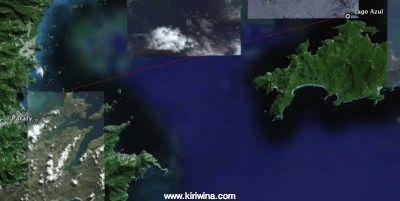
Leaving at 08:45 I motor sailed until 13:30 when a very helpful ESE breeze of 20 knots sprang up. This was lovely and it was a sleigh ride all the way to Baia Paraty, down the bay and into the anchorage where I anchored without using the engine.

Lago Azul
25/11/08 20:11 Filed in: Brazil | Ilha Grande
I got an early start from Praia Maguaraquissaba in case the wind got up strongly again, leaving at 09:00.
On the way up to Lago Azul a massive offshore production platform, Petrobras 51, was anchored.
Petrobras 51
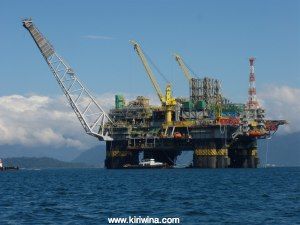
She is brand new having been christened in October and is the first semi-submersible production platform to be built entirely in Brazil. Rolls Royce was one of many in the consortium who built her at a cost of Reals B$1 Billion.
When deployed later this year in the Campo basin she will operate in waters 1200 metres deep.
Approaching the anchorage at Lago Azul.
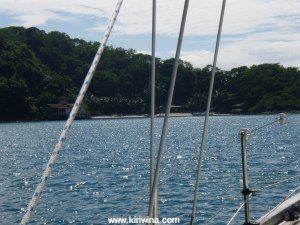
I anchored in Lago Azul at 10:30. The french yacht "Makao" with Kate and Mathew aboard had arrived earlier. They are bound for Argentina and the Pacific.
The weather remained unsettled and Makao left late in the afternoon. I had the anchorage to myself overnight but with variable winds and strong gusts it was not particularly relaxing.
Lago Azul is a lovely spot but with a mostly rocky foreshore I felt it was not ideal in unsettled conditions.
On the way up to Lago Azul a massive offshore production platform, Petrobras 51, was anchored.
Petrobras 51

She is brand new having been christened in October and is the first semi-submersible production platform to be built entirely in Brazil. Rolls Royce was one of many in the consortium who built her at a cost of Reals B$1 Billion.
When deployed later this year in the Campo basin she will operate in waters 1200 metres deep.
Approaching the anchorage at Lago Azul.

I anchored in Lago Azul at 10:30. The french yacht "Makao" with Kate and Mathew aboard had arrived earlier. They are bound for Argentina and the Pacific.
The weather remained unsettled and Makao left late in the afternoon. I had the anchorage to myself overnight but with variable winds and strong gusts it was not particularly relaxing.
Lago Azul is a lovely spot but with a mostly rocky foreshore I felt it was not ideal in unsettled conditions.
Ilha Cotia to Lago Azul
24/11/08 22:54 Filed in: Brazil | Ilha Grande
At Ilha Cotia it was a lovely morning, fine and clear with no wind.
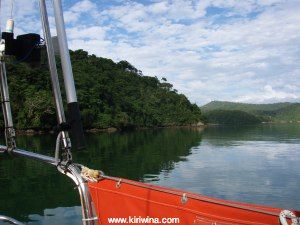
I weighed anchor at 10:00 bound for Lago Azul some 26 miles to the north east and made good progress until around 14:30.
About 6-7 miles from Lago Azul the wind having died then started to blow from the NE. 10kn, 12kn, 15kn, 20kn, at which point I starting to motor tack and divert to the nearest bay which was Sitio Forte and which the pilot book says is safe in all weathers. Uh, huh! 22kn, 25kn 28kn. It started getting a bit interesting. It wasn't cold but wind over tide made the seas short and steep, but not very big. The dinghy started to look a bit unstable. The barometer was down one point to 1015.
30kn, 32kn, 34kn. On the seventh tack I got into Sitio Forte, cutting the corner a bit fine, and headed for a bay in the SE corner. It took me over 2 hours to do less than 4 miles. I looked back at the dinghy which was now upside down. When I got there it was a gale 32-34 knots and three yachts already there were looking distinctly uncomfortable with 2 skippers on deck not looking very happy.
I didn't like the look of it at all. The wind seemed to be coming over the top and belting down into the bay. The gusts could be followed by watching the trees. The net effect was that this and other bays on the SW corner of and island with huge hills in between offered little shelter from a NE wind apart from a small fetch. The sea was just choppy but the wind was pushing boats all over the place.
I went a few bays up to Praia Maguaraquissaba and found a place where a lot of local boats had moorings and anchored outside them in 9m with 35m of cable. It was still blowing 30kn at 18:45 when I got there. Two of the three yachts in the first bay upped anchor and shifted as well. The wind faded away overnight.
Plotter image showing straight line made good until the wind sprang up and then my erratic course to Praia Maguaraquissaba.
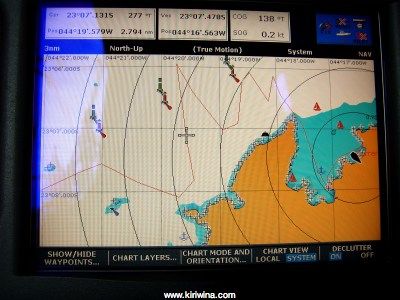

I weighed anchor at 10:00 bound for Lago Azul some 26 miles to the north east and made good progress until around 14:30.
About 6-7 miles from Lago Azul the wind having died then started to blow from the NE. 10kn, 12kn, 15kn, 20kn, at which point I starting to motor tack and divert to the nearest bay which was Sitio Forte and which the pilot book says is safe in all weathers. Uh, huh! 22kn, 25kn 28kn. It started getting a bit interesting. It wasn't cold but wind over tide made the seas short and steep, but not very big. The dinghy started to look a bit unstable. The barometer was down one point to 1015.
30kn, 32kn, 34kn. On the seventh tack I got into Sitio Forte, cutting the corner a bit fine, and headed for a bay in the SE corner. It took me over 2 hours to do less than 4 miles. I looked back at the dinghy which was now upside down. When I got there it was a gale 32-34 knots and three yachts already there were looking distinctly uncomfortable with 2 skippers on deck not looking very happy.
I didn't like the look of it at all. The wind seemed to be coming over the top and belting down into the bay. The gusts could be followed by watching the trees. The net effect was that this and other bays on the SW corner of and island with huge hills in between offered little shelter from a NE wind apart from a small fetch. The sea was just choppy but the wind was pushing boats all over the place.
I went a few bays up to Praia Maguaraquissaba and found a place where a lot of local boats had moorings and anchored outside them in 9m with 35m of cable. It was still blowing 30kn at 18:45 when I got there. Two of the three yachts in the first bay upped anchor and shifted as well. The wind faded away overnight.
Plotter image showing straight line made good until the wind sprang up and then my erratic course to Praia Maguaraquissaba.

Ilha Cotia
23/11/08 20:42 Filed in: Brazil | Ilha Grande
I went ashore for a quick walk around and then went for a row around Ilha Cotia which took about and hour and a half.
Narrow strip of land dividing the anchorage and south coast of Ilha Cotia.
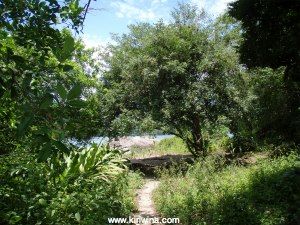
Kiriwina off the anchorage beach.
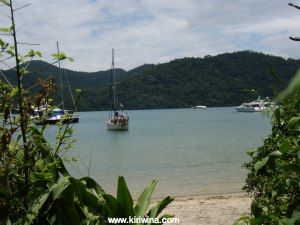
Cacti and other plants gradually colonising a rock face...
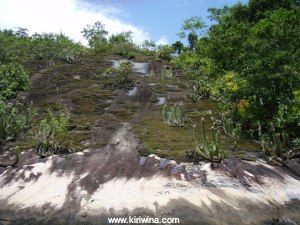
...and this large off-lying rock.
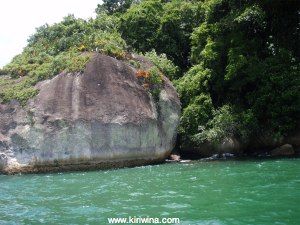
South side of Ilha Cotia opposite the anchorage.
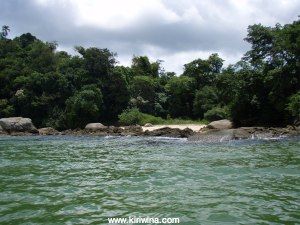
Narrow strip of land dividing the anchorage and south coast of Ilha Cotia.

Kiriwina off the anchorage beach.

Cacti and other plants gradually colonising a rock face...

...and this large off-lying rock.

South side of Ilha Cotia opposite the anchorage.

Ilha Cotia
22/11/08 21:36 Filed in: Brazil | Ilha Grande
Menkar moved off to explore other anchorages. I decided to don m mask and fins to scrub some more barnacles and weed from Kiriwina's hull. The anti fouling paint, which was applied only a year ago is having little effect.
Later in the day Arpoadora's helicopter entertained the anchorage with it's comings and goings.
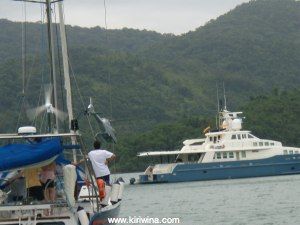
Later in the day Arpoadora's helicopter entertained the anchorage with it's comings and goings.

Ilha Cotia
21/11/08 22:22 Filed in: Brazil | Ilha Grande
Another lovely day in paradise so I went for a row around the bay.
This really is a nice spot. The vegetation is rampant colonising every possible bit of space,
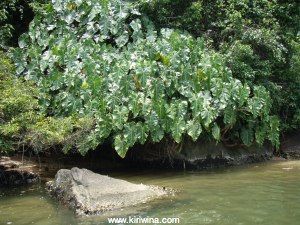
including cracks in off-lying rocks.
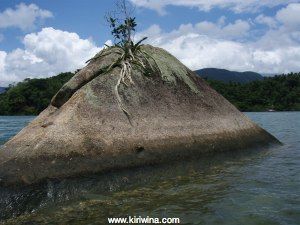
Giles and Dominique on "Menkar" arrived yesterday and anchored in a bay only "Menkar" with her shoal draft could reach.
I got a lift with them back to the main anchorage against a strengthening headwind. A large Brazilian boat "Arpoadora" had arrived along with many other boats.
"Arpoadora" is a large brazilian motor cruiser complete with flight deck and helicopter. No inconvenient passages to nice places. Simply order the crew to whatever destination required and have the helicopter ferry owners and guests to the boat.
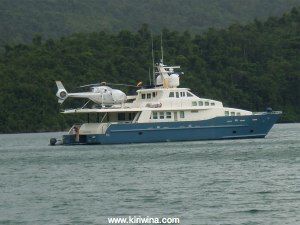
This is obviously a poplar spot with 22 boats currently at anchor at the beginning of the weekend.
N
This really is a nice spot. The vegetation is rampant colonising every possible bit of space,

including cracks in off-lying rocks.

Giles and Dominique on "Menkar" arrived yesterday and anchored in a bay only "Menkar" with her shoal draft could reach.
I got a lift with them back to the main anchorage against a strengthening headwind. A large Brazilian boat "Arpoadora" had arrived along with many other boats.
"Arpoadora" is a large brazilian motor cruiser complete with flight deck and helicopter. No inconvenient passages to nice places. Simply order the crew to whatever destination required and have the helicopter ferry owners and guests to the boat.

This is obviously a poplar spot with 22 boats currently at anchor at the beginning of the weekend.
N
Ilha Cotia
20/11/08 20:34 Filed in: Brazil | Ilha Grande
It was only 2 miles round to Ilha da Cotia so I slept in, left at 12:40 and anchored off a little beach on the northern side at 13:30.
This is a very pretty spot with good shelter and clear water. There were only three other boats at anchor.
Approaches to Ilha Cotia.
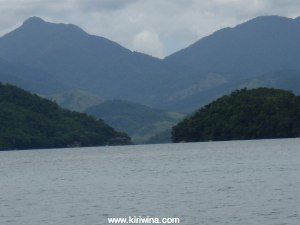
This is a very pretty spot with good shelter and clear water. There were only three other boats at anchor.
Approaches to Ilha Cotia.

Saco de Velha
19/11/08 22:09 Filed in: Brazil | Ilha Grande
There are lots of outlying anchorages in the area so I left Paraty at 14:30 and motorsailed round to Saco de Velha in very heavy rain.
This is a small bay about 7.5 miles from Paraty where there is a restaurant said to be amongst the best in the area.
I anchored there just after 17:00. The restaurant was closed.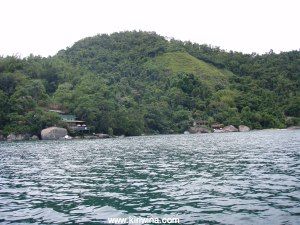
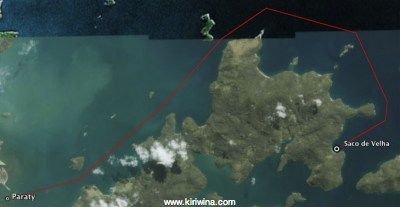
This is a small bay about 7.5 miles from Paraty where there is a restaurant said to be amongst the best in the area.
I anchored there just after 17:00. The restaurant was closed.


Paraty
18/11/08 21:35 Filed in: Brazil | Ilha Grande
I weighed anchor at 11:10, a very muddy chain this time, and motored over to Porto Imperial for bunkers. This is a new marina and very swish. They even paint the tyre fenders white on the bunker berth.
I'm not quite sure what Diesel Verano is but at R$2.72 it cost a lot more than regular diesel at R$2.40. Maybe Kiriwina will now go faster under engine.
Anyway I took 142 litres at a cost of R$384 (ouch). The whole process was very efficient taking only about 10 minutes after which I anchored off Paraty jetty in 2.8m of water.
Petrobras bunker berth at Porto Imperial.
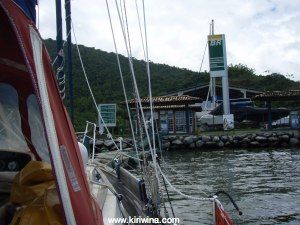
The plan was to nip ashore for some last minute shopping and then go round to one of the beaches in the next bay Enseada de Paraty Mirim.
Events intervened. Firstly I rowed 3/4 of a mile ashore to discover I had left the dinghy padlock aboard. Back to the boat to retrieve it.
Nearing high tide some streets beginning to flood.
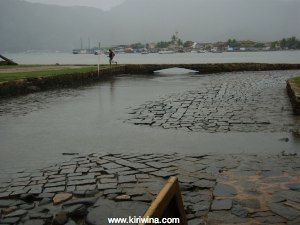
By the time I got back on board it was late afternoon and starting to rain heavily. I decided to stay put.
A boatyard not far from Paraty jetty where yachties are allowed to leave their dinghies an a more secure location.
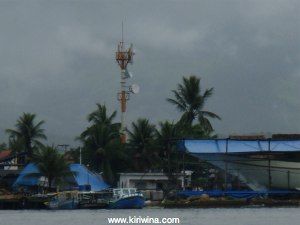
I'm not quite sure what Diesel Verano is but at R$2.72 it cost a lot more than regular diesel at R$2.40. Maybe Kiriwina will now go faster under engine.
Anyway I took 142 litres at a cost of R$384 (ouch). The whole process was very efficient taking only about 10 minutes after which I anchored off Paraty jetty in 2.8m of water.
Petrobras bunker berth at Porto Imperial.

The plan was to nip ashore for some last minute shopping and then go round to one of the beaches in the next bay Enseada de Paraty Mirim.
Events intervened. Firstly I rowed 3/4 of a mile ashore to discover I had left the dinghy padlock aboard. Back to the boat to retrieve it.
Nearing high tide some streets beginning to flood.

By the time I got back on board it was late afternoon and starting to rain heavily. I decided to stay put.
A boatyard not far from Paraty jetty where yachties are allowed to leave their dinghies an a more secure location.

Paraty
17/11/08 21:15 Filed in: Brazil | Ilha Grande
Sunday started off with quite nice weather but then it deteriorated into a series of thunder storms. A good day for staying aboard and reading a book.
I noticed that by dropping one corner of my bimini I could catch a lot of water and managed to collect 10 litres during the day.
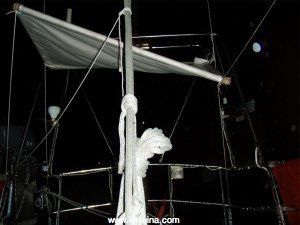
Monday was more of the same except that it rained all day. Heavy and continuous tropical rain.
Now I was on a mission to collect as much water as possible. Using the bimini and a bucket I collected 35 litres in jerry cans and bottles. By plugging the port scuppers and opening the filler cup clean fresh water flowed directly into the tanks, topping them up with another 60 litres.
As the rain eased towards evening all my fresh water storage was full.
I noticed that by dropping one corner of my bimini I could catch a lot of water and managed to collect 10 litres during the day.

Monday was more of the same except that it rained all day. Heavy and continuous tropical rain.
Now I was on a mission to collect as much water as possible. Using the bimini and a bucket I collected 35 litres in jerry cans and bottles. By plugging the port scuppers and opening the filler cup clean fresh water flowed directly into the tanks, topping them up with another 60 litres.
As the rain eased towards evening all my fresh water storage was full.
Paraty
15/11/08 21:14 Filed in: Brazil | Ilha Grande
Another bus trip into Paraty. Mainly to take advantage of the laundry I noticed yesterday next to the bus station.
Outstanding service. A 2 1/2 hour turnaround.
While wandering about I met Bernadette and Ronaldo, a german/brazillian couple who were based in Itaparica when I was there. They are now running charters on their yacht Leoaloucal based at Marina Engenho and I caught the bus back with them to the first marina, Porto Imperial.
From there we returned in their dinghy. A useful recce of the channel into Porto Imperial where I want to take bunkers. This is not in my charts and a marked channel needs to be followed to avoid offlying rocks.
Outstanding service. A 2 1/2 hour turnaround.
While wandering about I met Bernadette and Ronaldo, a german/brazillian couple who were based in Itaparica when I was there. They are now running charters on their yacht Leoaloucal based at Marina Engenho and I caught the bus back with them to the first marina, Porto Imperial.
From there we returned in their dinghy. A useful recce of the channel into Porto Imperial where I want to take bunkers. This is not in my charts and a marked channel needs to be followed to avoid offlying rocks.
Paraty
14/11/08 20:13 Filed in: Brazil | Ilha Grande
I was in two minds about whether to dinghy over to Paraty or get the bus. Marinha Engenho allow dinghies to be moored to their pontoon so I left the dinghy there and walked about half a mile to the main road where I caught a bus into town. Cost R$2.60.
Marina Engenho and the anchorage beyond.
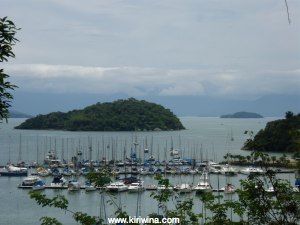
The bus station is pretty close to central Paraty and the trip only took about 10 minutes. There is a large supermarket across the road.
Paraty is very picturesque and seem entirely devoted to tourism, at least in the centre. It is a Unesco world heritage site.
For me the most interesting feature was the way the town was built to allow high tides to flush the streets.
Church and square viewed across a canal that divides the town centre from a beach area.
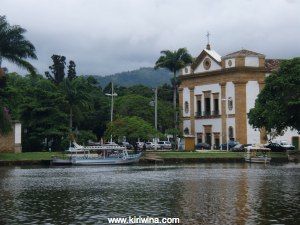
A typical street with the paving in a shallow V to allow drainage.
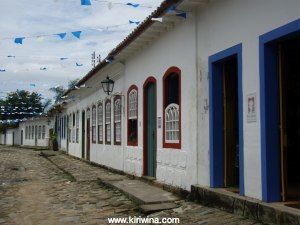
The main pier with large tourist schooners.
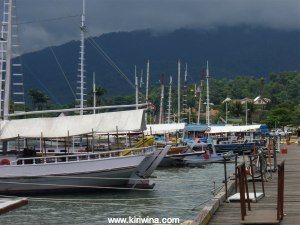
It is a very long pier. Closer to shore are the smaller day trip launches that can be hired individually.
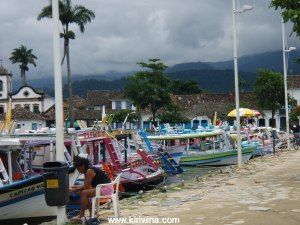
Town centre square with sunken street paving.
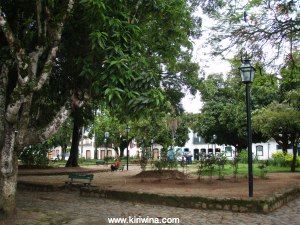
At high water the water level almost reached sluice level. It generally does so only at Spring tides.
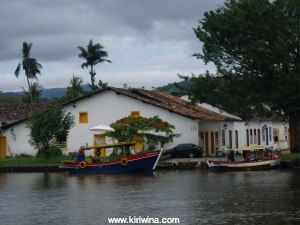
One of the sluices which alows sea water to flood the streets.
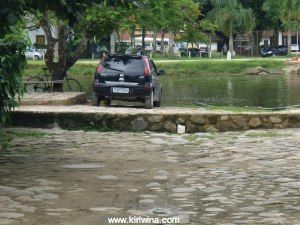
Marina Engenho and the anchorage beyond.

The bus station is pretty close to central Paraty and the trip only took about 10 minutes. There is a large supermarket across the road.
Paraty is very picturesque and seem entirely devoted to tourism, at least in the centre. It is a Unesco world heritage site.
For me the most interesting feature was the way the town was built to allow high tides to flush the streets.
Church and square viewed across a canal that divides the town centre from a beach area.

A typical street with the paving in a shallow V to allow drainage.

The main pier with large tourist schooners.

It is a very long pier. Closer to shore are the smaller day trip launches that can be hired individually.

Town centre square with sunken street paving.

At high water the water level almost reached sluice level. It generally does so only at Spring tides.

One of the sluices which alows sea water to flood the streets.

Praia de Ubatuba to Paraty
13/11/08 22:12 Filed in: Bahia | Ilha Grande
At 11:30 I dropped the mooring off Praia de Ubatuba and proceeded to Paraty, a distance of about 25 miles. Initially it was good sailing but by 15:00 the wind died away and I had to motor.
Approaching Ilha Mantimento at the entrance to Baia de Parati the heavens opened and it rained, very heavily. Visibility dropped to about 1 mile.
It continued to rain until I dropped anchor off Marina Engenho in the SE corner of Baia de Paraty.
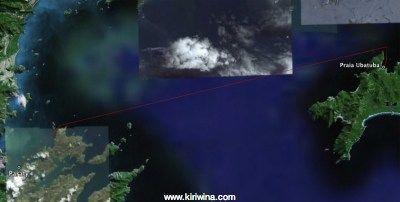
Approaching Ilha Mantimento at the entrance to Baia de Parati the heavens opened and it rained, very heavily. Visibility dropped to about 1 mile.
It continued to rain until I dropped anchor off Marina Engenho in the SE corner of Baia de Paraty.

Saco de Seu to Praia de Ubatuba
12/11/08 22:07 Filed in: Brazil | Ilha Grande
It rained quite heavily last night. Looks like we may be in for some bad weather. I weighed anchor at 12:45 for the run round to Praia de Ubatuba, about 9 miles.
Western shore of Saco do Ceu.
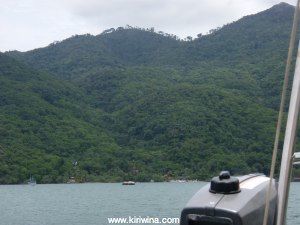
Again it was possible to sail most of the way with a 20 not NE wind building up as the afternoon wore on.
At Praia de Ubatuba I picked up a mooring some way off the beach. There were a couple of other yachts on buoys but otherwise the place was deserted. A restaurant/pousada was open at the western end but another reported restaurant in a converted canning factory at the eastern end was derelict.
Anchorage at Praia de Ubatuba.
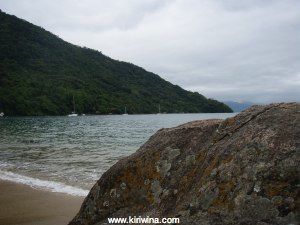
Geese on the beach.
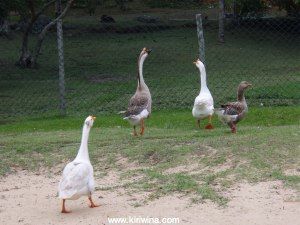
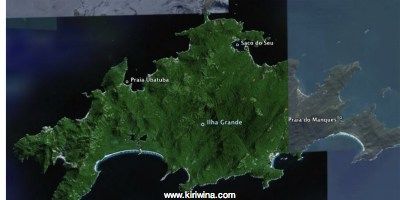
Western shore of Saco do Ceu.

Again it was possible to sail most of the way with a 20 not NE wind building up as the afternoon wore on.
At Praia de Ubatuba I picked up a mooring some way off the beach. There were a couple of other yachts on buoys but otherwise the place was deserted. A restaurant/pousada was open at the western end but another reported restaurant in a converted canning factory at the eastern end was derelict.
Anchorage at Praia de Ubatuba.

Geese on the beach.


Praia dos Manques to Saco do Seu
11/11/08 22:47 Filed in: Brazil | Ilha Grande
Time to move on. I was going to Saco do Ceu (Sky Cove) while Menkar and Tatuaga were going to Angra dos Reis.
Giles and Dominique on Menkar
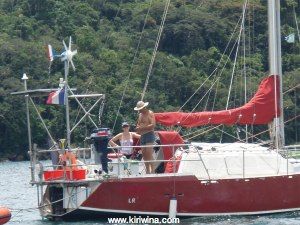
The two ridges I crossed on Sunday.
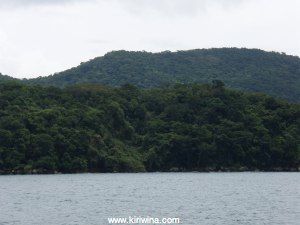
Menkar and Tatuaga
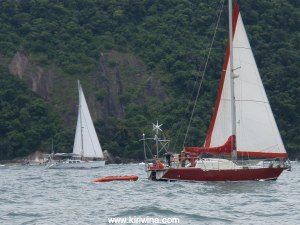
Saco do Seu is an almost fully enclosed anchorage on the NE coast of Ilha Grande about 7.5 miles from Praia dos Manques. The wind picked up once clear of Enseada das Palmas and I was able to sail most of the way.
I chose to anchor on the western side of Saco do Ceu off a small fishing village. The cove is surrounded by steep rain forest giving way to mangroves in places along the shore. Where the shore is built up there is an odd mixture of fishing villages and and gated resorts. I went for a quick walk ashore before it started to rain.
Rain forest - Saco do Seu.
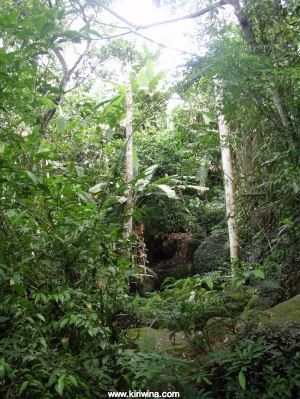

Giles and Dominique on Menkar

The two ridges I crossed on Sunday.

Menkar and Tatuaga

Saco do Seu is an almost fully enclosed anchorage on the NE coast of Ilha Grande about 7.5 miles from Praia dos Manques. The wind picked up once clear of Enseada das Palmas and I was able to sail most of the way.
I chose to anchor on the western side of Saco do Ceu off a small fishing village. The cove is surrounded by steep rain forest giving way to mangroves in places along the shore. Where the shore is built up there is an odd mixture of fishing villages and and gated resorts. I went for a quick walk ashore before it started to rain.
Rain forest - Saco do Seu.


Praia dos Manques
10/11/08 22:48 Filed in: Brazil | Ilha Grande
Giles and I had a vague plan to move on today. He came over in the morning to say goodbye but we were joined by Guido who has been sailing this coast for over 20 years and was a mine of useful information. In particular he stressd the necessity not to sail further south before the beginning of December. Suddenly were we in no particular hurry to go anywhere.
After he had shown us a selection of stopovers on the way south and a recommended route along the coast of Uruguay into the river Plate estuary we moved over to Menkar for lunch.
Menkar
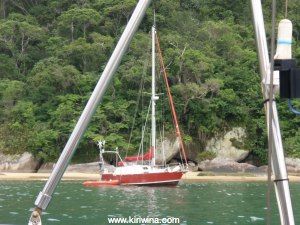
Then later in the evening we went aboard Tatagua for an Argentine asado. Guido was in the meat business and themeal was delicious. Tatagua is a one off design built for Guido in Buenos Aires. She is a 47ft steel cutter, beautifully fitted out with a large light and airy saloon. I particularly liked the workshop he had installed in the forecastle.
Tatagua
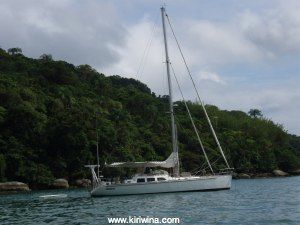
After he had shown us a selection of stopovers on the way south and a recommended route along the coast of Uruguay into the river Plate estuary we moved over to Menkar for lunch.
Menkar

Then later in the evening we went aboard Tatagua for an Argentine asado. Guido was in the meat business and themeal was delicious. Tatagua is a one off design built for Guido in Buenos Aires. She is a 47ft steel cutter, beautifully fitted out with a large light and airy saloon. I particularly liked the workshop he had installed in the forecastle.
Tatagua

Praia dos Manques and Abraão.
09/11/08 21:30 Filed in: Brazil | Ilha Grande
In the afternoon I took a long work over two ridges to Abraão, the largest town on Ilha Grande.
It was a spectacular route. Firstly up over a low ridge to Praia Grande des Palmas. Then along the beach and then up a very steep path through what looked like an enormous botanical garden, over the second ridge and down to Abraão.
A secluded bay just to the east of Abraão.
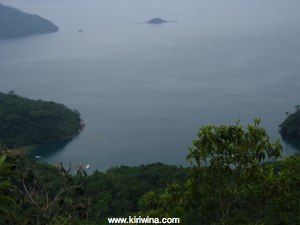
Abraão is a much larger place with extensive tourist facilities and a very crowded waterfront. There are lots of pousadas and restaurants and quite a few shi shi shops. The anchorage was crowded with schooners, launches and private craft but the yacht anchorage away to the eastern end of the beach was very quiet.
Abraão viewed from the high ridge.
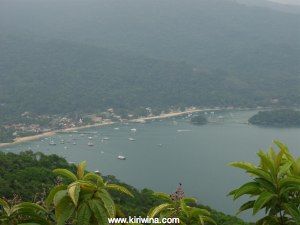
it was not a particularly attractive place but I was able to top up my dwindling food stocks and check e-mail.
By the time I had walked back to Praia do Manques I knew I had been for a walk. On the beach I met an Argentine couple, Guido and Veronique just arrived on their newly built 48ft steel boat Tatagua.
It was a spectacular route. Firstly up over a low ridge to Praia Grande des Palmas. Then along the beach and then up a very steep path through what looked like an enormous botanical garden, over the second ridge and down to Abraão.
A secluded bay just to the east of Abraão.

Abraão is a much larger place with extensive tourist facilities and a very crowded waterfront. There are lots of pousadas and restaurants and quite a few shi shi shops. The anchorage was crowded with schooners, launches and private craft but the yacht anchorage away to the eastern end of the beach was very quiet.
Abraão viewed from the high ridge.

it was not a particularly attractive place but I was able to top up my dwindling food stocks and check e-mail.
By the time I had walked back to Praia do Manques I knew I had been for a walk. On the beach I met an Argentine couple, Guido and Veronique just arrived on their newly built 48ft steel boat Tatagua.
Praia dos Manques and environs.
08/11/08 22:12 Filed in: Brazil | Ilha Grande
I finished cleaning the dinghy and fitted anti chafe plastic to the cross trees and Aries lines.
Sadly there continues to be a leak in the wardrobe and a new leak has appeared in the aft galley locker. No doubt caused by more undiscovered holes in the deck head.
Then I went ashore for a walk over to Praia Lopez Mendes. This is said to be one of the best surf beaches in Brazil and was a 20 minute walk away over a nearby ridge to the other side of Ilha Grande.
The eastern side of Prais do Manques
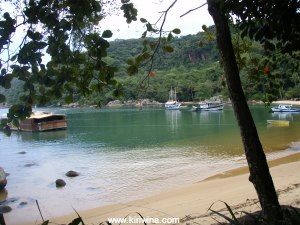
Giant bamboos along the path...
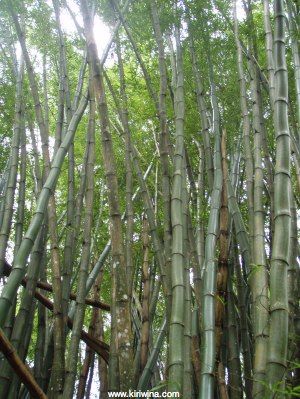
...and Marmosets as well.
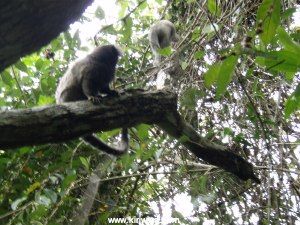
Praia Lopez Mendes
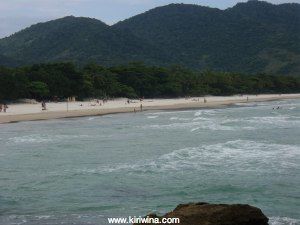
Shoreline at the western end of the beach.
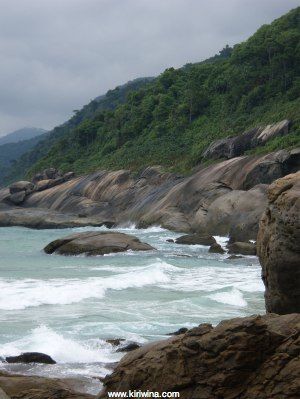
A penguin swimming near the rocks.
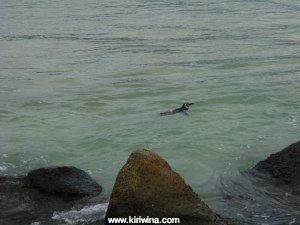
The anchorage seen from the top of the ridge.
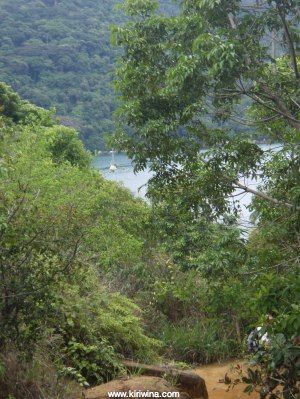
Sadly there continues to be a leak in the wardrobe and a new leak has appeared in the aft galley locker. No doubt caused by more undiscovered holes in the deck head.
Then I went ashore for a walk over to Praia Lopez Mendes. This is said to be one of the best surf beaches in Brazil and was a 20 minute walk away over a nearby ridge to the other side of Ilha Grande.
The eastern side of Prais do Manques

Giant bamboos along the path...

...and Marmosets as well.

Praia Lopez Mendes

Shoreline at the western end of the beach.

A penguin swimming near the rocks.

The anchorage seen from the top of the ridge.

Praia dos Manques
07/11/08 21:59 Filed in: Brazil | Ilha Grande
This is a lovely spot. Very sheltered with clear blue water and a clean sandy beach.
I went for a morning swim before starting to clean off the barnacles and grime which accumulated on the dinghy in Galeao.
Giles and Dominique took me ashore in their dinghy for a short walk around the beach. At the western end a fresh water creek which becomes brackish at high water is useful for laundry and washing.
Western edge of Praia do Manques.
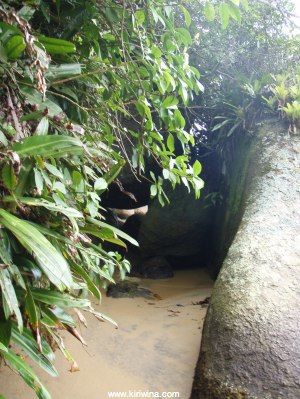
The anchorage.
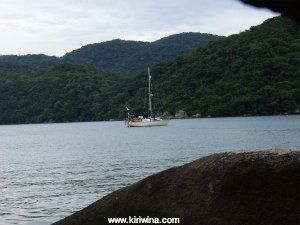
Fresh water creek at Praia do Manques.
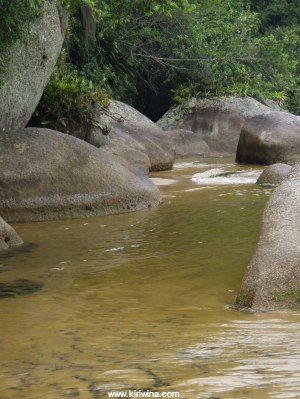
Ilha Grande is completely different to the Costa Dende. Here it is spectacular tropical rainforest on steep sided mountains.
Later I passed the afternoon aboard Menkar with Giles and Dominique followed by an early night and another long sleep.

I went for a morning swim before starting to clean off the barnacles and grime which accumulated on the dinghy in Galeao.
Giles and Dominique took me ashore in their dinghy for a short walk around the beach. At the western end a fresh water creek which becomes brackish at high water is useful for laundry and washing.
Western edge of Praia do Manques.

The anchorage.

Fresh water creek at Praia do Manques.

Ilha Grande is completely different to the Costa Dende. Here it is spectacular tropical rainforest on steep sided mountains.
Later I passed the afternoon aboard Menkar with Giles and Dominique followed by an early night and another long sleep.

On Passage 1-6 November
06/11/08 22:45 Filed in: Brazil
Day 4 - Saturday 1st November 2008
The wind died away during the early hours and when I awoke from a short sleep at 05:00 it was raining heavily and Kiriwina was heading slowly NW in a SW breeze.
I beat into this wind for about an hour with little progress. Then the wind died leaving a calm sea and light rain. As the Abrolhos islands were not too far away to starboard I started the engine and continued under power.
A lone fishing boat was sighted inshore. Fishing boats in these waters make me slightly nervous as there have been reports of piracy as far south as the Abrolhos. This one slowly disappeared from view astern.
Noon Run: 76.5 miles
More whales jumped and spouted in the distance.
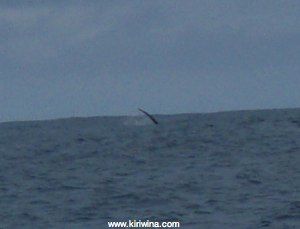
It was a very frustrating day. Rain, calms and the wind from dead ahead. Finally, around 15:00, a good SE F5 wind took us rapidly away from the Abrolhos towards Cabo Sao Tome and an increasing amount of shipping traffic.
Day 5 - Sunday 2nd November 2008
The SE F5 wind continued until daybreak when it backed and weakened. By 12:00 it was fine on the starboard beam at ENE F4 where it stayed for a few hours before backing NE.
It was becoming busy with fishing boats, commercial ships and more whales, though none came close.
Noon Run: 95.95 miles. A large charted oil/gas rig was sighted at noon, fine on the starboard bow.
Afternoon sun reflecting on the waves
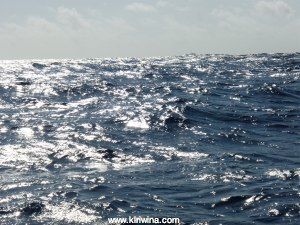
At 18:00 a northbound naval vessel passed inshore.
Later in the evening three uncharted oil/gas rigs lit up like christmas trees were visible to seaward.
Day 6 - Monday 3rd November 2008
By 04:00 the wind backed to between N and NW F5 so I gybed to put the wind on the starboard quarter. In this wind the Superwind is keeping up well with electricity consumption.
Noon Run: 92.30 miles
Kiriwina was making good speed in these conditions. At 14:00 the wind increased to F6, gusting to 27 knots, and I put 2 reefs in the main.
Later a number of rigs were visible to seaward. These were uncharted and the giant Pampas field was still some way to the south.
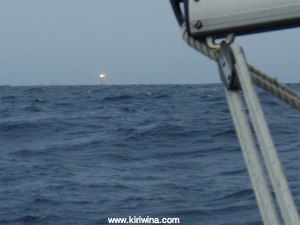
A large southbound car carrier, Gran Cosmo, passed to seaward around 18:00.
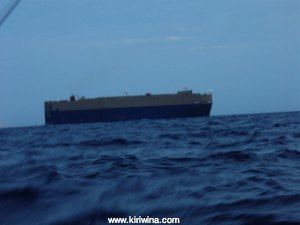
This favourable wind was not to last. At 21:00 the weather changed. Frequent changes in wind speed and direction with heavy rain were followed by a flat calm. Reluctantly I started motoring at 23:00.
Day 7 - Tuesday 4th November 2008
It stopped raining during the early hours. Dawn revealed a flat calm sea with a gentle southerly breeze. I continued to motor.
Lack of wind apart it was a lovely sunny day with lots of passing ships. I took the opportunity to practise with the MARPA anti collision feature on the radar.
Noon Run: 90.94 miles. Not bad considering the lack of progress last evening.
A huge southbound crane barge passed to seaward likely bound for the Pampas oil/gas field.
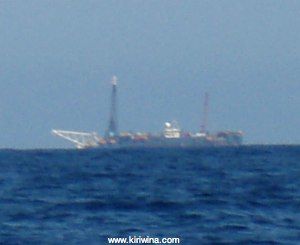
I'd been hoping that the wind would back and strengthen. Finally at around 15:00 it did a bit and I was able to set the yankee and staysail, reduce engine revs and still achieve 4.5-5.0 knots.
During the evening the wind died away to be replaced by heavy thunder storms some of which briefly produced winds in excess of 20 knots as they passed.
Vessel traffic was very heavy as Cabo Frio was neared. My MARPA practice was quite timely as it proved to be very useful during the night.
Day 8 - Wednesday 5th November 2008
Cabo Frio (so named because of lower temperatures caused by the upwelling of a subsurface antarctic cold water current) was approached in light airs.
There were two Brazilian warships in the area. F40 and F48 "Bosisio"
F40 is a Niteroi class frigate built by Vosper Thorneycroft in the UK in 1976.
F48 "Bosisio". She was previously the HMS Brazen, a Type 22 frigate sold to Brazil in 1996.
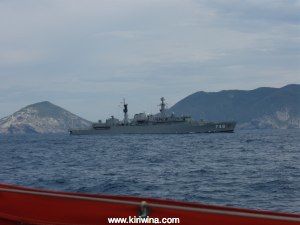
At 10:00, near Cabo Frio, F48 came to within a couple of cables and called on the VHF. I responded and they asked a few routine questions before speeding off to join F40. Later Rio de Janeiro radio broadcast a navigational warning giving naval exercise area co-ordinates off Cabo Frio.
I had wandered into this area. However, I had not heard any prior broadcast and there was no indication of this activity on my charts. At least two large ships also steamed through as well.
With Cabo Frio dropping astern a light NE wind F2-3 began blowing. I opted for a downwind rig with the yankee poled out to starboard and the main sheeted out to port. Later, when the wind veered to ESE and increased to F4 I reverted to normal rig with all sails up.
Late in the afternoon the Brazilian flag RoRo "Intrepido" passed less than a mile off to starboard.
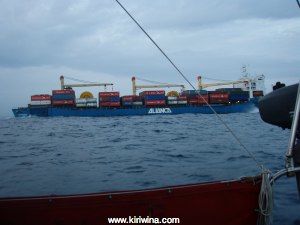
Towards sunset the wind began to drop and the horizon became distinctly misty. By 20:20 it was calm with dense fog and I had to resort again to the engine.
Day 9 - Thursday 6th November 2008
I had anticipated a bit of a light show while passing the entrance to Rio de Janeiro. Instead I saw nothing in dense fog. To add a bit of drama the engine alternator belt began to self destruct when the entrance to Rio was abeam at 00:40. The radar showed a few ships in the area but none looked dangerous. I stopped the engine and fitted a new belt and westward passage was resumed after 35 minutes.
Shredded alternator belt.
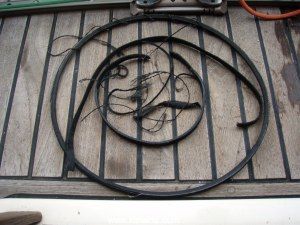
At dawn it was still foggy but visibility had improved to 2-3 miles. The coast here is a bit deceptive. One first sees high land but this is well back from the low lying coastline.
High ground poking out of the fog between Rio de Janeiro and Ilha Grande.
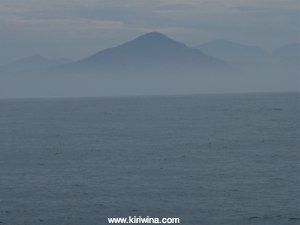
At 08:48 Laje da Marambaia was passed close abeam to starboard. This is described in the pilot book as a small rock but it looked pretty big to me.
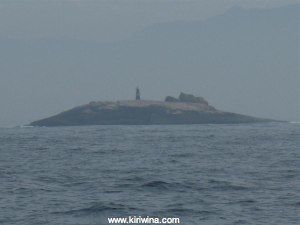
It was still calm with no wind when the entrance to Baia Ilha Grande was passed. The fog had lifted though there was still haze on the horizon.
Just after 12:00 Kiriwina entered Enseada das Palmas and at 12:40 anchored off Praia des Manques at the head of the bay.
Approaching Enseada das Palmas.
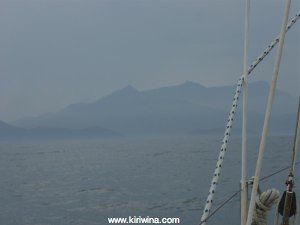
Passing Palm Island on the way in.
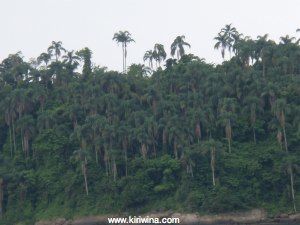
The anchorage.
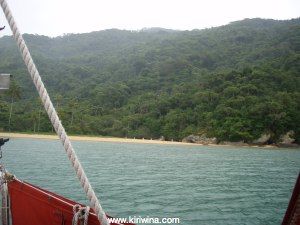
Total distance 817.16 miles in 8 days 6 hours.
I noticed a familiar red boat in the anchorage. Giles on "Menkar", who I had last seen in Boipeba at the end of September had arrived a few hours earlier.
I had been up all night and fell into my bunk for a few hours sleep.
Later, Giles and Dominique came over for a drink and to catch up.
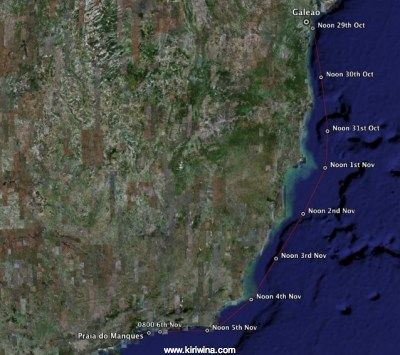
The wind died away during the early hours and when I awoke from a short sleep at 05:00 it was raining heavily and Kiriwina was heading slowly NW in a SW breeze.
I beat into this wind for about an hour with little progress. Then the wind died leaving a calm sea and light rain. As the Abrolhos islands were not too far away to starboard I started the engine and continued under power.
A lone fishing boat was sighted inshore. Fishing boats in these waters make me slightly nervous as there have been reports of piracy as far south as the Abrolhos. This one slowly disappeared from view astern.
Noon Run: 76.5 miles
More whales jumped and spouted in the distance.

It was a very frustrating day. Rain, calms and the wind from dead ahead. Finally, around 15:00, a good SE F5 wind took us rapidly away from the Abrolhos towards Cabo Sao Tome and an increasing amount of shipping traffic.
Day 5 - Sunday 2nd November 2008
The SE F5 wind continued until daybreak when it backed and weakened. By 12:00 it was fine on the starboard beam at ENE F4 where it stayed for a few hours before backing NE.
It was becoming busy with fishing boats, commercial ships and more whales, though none came close.
Noon Run: 95.95 miles. A large charted oil/gas rig was sighted at noon, fine on the starboard bow.
Afternoon sun reflecting on the waves

At 18:00 a northbound naval vessel passed inshore.
Later in the evening three uncharted oil/gas rigs lit up like christmas trees were visible to seaward.
Day 6 - Monday 3rd November 2008
By 04:00 the wind backed to between N and NW F5 so I gybed to put the wind on the starboard quarter. In this wind the Superwind is keeping up well with electricity consumption.
Noon Run: 92.30 miles
Kiriwina was making good speed in these conditions. At 14:00 the wind increased to F6, gusting to 27 knots, and I put 2 reefs in the main.
Later a number of rigs were visible to seaward. These were uncharted and the giant Pampas field was still some way to the south.

A large southbound car carrier, Gran Cosmo, passed to seaward around 18:00.

This favourable wind was not to last. At 21:00 the weather changed. Frequent changes in wind speed and direction with heavy rain were followed by a flat calm. Reluctantly I started motoring at 23:00.
Day 7 - Tuesday 4th November 2008
It stopped raining during the early hours. Dawn revealed a flat calm sea with a gentle southerly breeze. I continued to motor.
Lack of wind apart it was a lovely sunny day with lots of passing ships. I took the opportunity to practise with the MARPA anti collision feature on the radar.
Noon Run: 90.94 miles. Not bad considering the lack of progress last evening.
A huge southbound crane barge passed to seaward likely bound for the Pampas oil/gas field.

I'd been hoping that the wind would back and strengthen. Finally at around 15:00 it did a bit and I was able to set the yankee and staysail, reduce engine revs and still achieve 4.5-5.0 knots.
During the evening the wind died away to be replaced by heavy thunder storms some of which briefly produced winds in excess of 20 knots as they passed.
Vessel traffic was very heavy as Cabo Frio was neared. My MARPA practice was quite timely as it proved to be very useful during the night.
Day 8 - Wednesday 5th November 2008
Cabo Frio (so named because of lower temperatures caused by the upwelling of a subsurface antarctic cold water current) was approached in light airs.
There were two Brazilian warships in the area. F40 and F48 "Bosisio"
F40 is a Niteroi class frigate built by Vosper Thorneycroft in the UK in 1976.
F48 "Bosisio". She was previously the HMS Brazen, a Type 22 frigate sold to Brazil in 1996.

At 10:00, near Cabo Frio, F48 came to within a couple of cables and called on the VHF. I responded and they asked a few routine questions before speeding off to join F40. Later Rio de Janeiro radio broadcast a navigational warning giving naval exercise area co-ordinates off Cabo Frio.
I had wandered into this area. However, I had not heard any prior broadcast and there was no indication of this activity on my charts. At least two large ships also steamed through as well.
With Cabo Frio dropping astern a light NE wind F2-3 began blowing. I opted for a downwind rig with the yankee poled out to starboard and the main sheeted out to port. Later, when the wind veered to ESE and increased to F4 I reverted to normal rig with all sails up.
Late in the afternoon the Brazilian flag RoRo "Intrepido" passed less than a mile off to starboard.

Towards sunset the wind began to drop and the horizon became distinctly misty. By 20:20 it was calm with dense fog and I had to resort again to the engine.
Day 9 - Thursday 6th November 2008
I had anticipated a bit of a light show while passing the entrance to Rio de Janeiro. Instead I saw nothing in dense fog. To add a bit of drama the engine alternator belt began to self destruct when the entrance to Rio was abeam at 00:40. The radar showed a few ships in the area but none looked dangerous. I stopped the engine and fitted a new belt and westward passage was resumed after 35 minutes.
Shredded alternator belt.

At dawn it was still foggy but visibility had improved to 2-3 miles. The coast here is a bit deceptive. One first sees high land but this is well back from the low lying coastline.
High ground poking out of the fog between Rio de Janeiro and Ilha Grande.

At 08:48 Laje da Marambaia was passed close abeam to starboard. This is described in the pilot book as a small rock but it looked pretty big to me.

It was still calm with no wind when the entrance to Baia Ilha Grande was passed. The fog had lifted though there was still haze on the horizon.
Just after 12:00 Kiriwina entered Enseada das Palmas and at 12:40 anchored off Praia des Manques at the head of the bay.
Approaching Enseada das Palmas.

Passing Palm Island on the way in.

The anchorage.

Total distance 817.16 miles in 8 days 6 hours.
I noticed a familiar red boat in the anchorage. Giles on "Menkar", who I had last seen in Boipeba at the end of September had arrived a few hours earlier.
I had been up all night and fell into my bunk for a few hours sleep.
Later, Giles and Dominique came over for a drink and to catch up.

